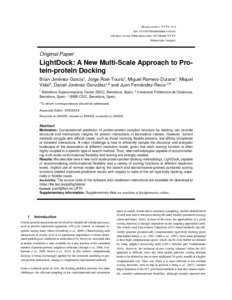Mostra el registre d'ítem simple
LightDock: a new multi-scale approach to protein–protein docking
| dc.contributor.author | Jiménez-García, Brian |
| dc.contributor.author | Roel-Touris, Jorge |
| dc.contributor.author | Romero-Durana, Miguel |
| dc.contributor.author | Vidal, Miquel |
| dc.contributor.author | Jiménez-González, Daniel |
| dc.contributor.author | Fernández-Recio, Juan |
| dc.contributor.other | Barcelona Supercomputing Center |
| dc.date.accessioned | 2018-03-07T10:45:31Z |
| dc.date.available | 2018-09-01T00:30:29Z |
| dc.date.issued | 2017-09-04 |
| dc.identifier.citation | Jiménez-García, B. [et al.]. LightDock: a new multi-scale approach to protein–protein docking. "Bioinformatics", 4 Setembre 2017, vol. 34, núm. 1, p. 49-55. |
| dc.identifier.issn | 1367-4803 |
| dc.identifier.uri | http://hdl.handle.net/2117/114893 |
| dc.description.abstract | Computational prediction of protein–protein complex structure by docking can provide structural and mechanistic insights for protein interactions of biomedical interest. However, current methods struggle with difficult cases, such as those involving flexible proteins, low-affinity complexes or transient interactions. A major challenge is how to efficiently sample the structural and energetic landscape of the association at different resolution levels, given that each scoring function is often highly coupled to a specific type of search method. Thus, new methodologies capable of accommodating multi-scale conformational flexibility and scoring are strongly needed. We describe here a new multi-scale protein–protein docking methodology, LightDock, capable of accommodating conformational flexibility and a variety of scoring functions at different resolution levels. Implicit use of normal modes during the search and atomic/coarse-grained combined scoring functions yielded improved predictive results with respect to state-of-the-art rigid-body docking, especially in flexible cases. |
| dc.description.sponsorship | B.J-G was supported by a FPI fellowship from the Spanish Ministry of Economy and Competitiveness. This work was supported by I+D+I Research Project grants BIO2013-48213-R and BIO2016-79930-R from the Spanish Ministry of Economy and Competitiveness. This work is partially supported by the European Union H2020 program through HiPEAC (GA 687698), by the Spanish Government through Programa Severo Ochoa (SEV-2015-0493), by the Spanish Ministry of Science and Technology (TIN2015-65316-P) and the Departament d’Innovació, Universitats i Empresa de la Generalitat de Catalunya, under project MPEXPAR: Models de Programaciói Entorns d’Execució Paral·lels (2014-SGR-1051). |
| dc.format.extent | 7 p. |
| dc.language.iso | eng |
| dc.publisher | Oxford University Press |
| dc.subject | Àrees temàtiques de la UPC::Enginyeria biomèdica |
| dc.subject.lcsh | Protein-protein interactions |
| dc.subject.other | Structural bioinformatics |
| dc.subject.other | Protein–protein |
| dc.subject.other | Protein docking |
| dc.title | LightDock: a new multi-scale approach to protein–protein docking |
| dc.type | Article |
| dc.subject.lemac | Proteïnes--Investigació |
| dc.identifier.doi | 10.1093/bioinformatics/btx555 |
| dc.description.peerreviewed | Peer Reviewed |
| dc.relation.publisherversion | https://academic.oup.com/bioinformatics/article-abstract/doi/10.1093/bioinformatics/btx555/4103399/LightDock-A-New-Multi-Scale-Approach-to-Protein?redirectedFrom=fulltext |
| dc.rights.access | Open Access |
| dc.description.version | Postprint (author's final draft) |
| dc.relation.projectid | info:eu-repo/grantAgreement/MINECO//BIO2013-48213-R/ES/DESARROLLO DE NUEVAS METODOLOGIAS DE DOCKING ENTRE PROTEINAS PARA LOS RETOS DE INTERACTOMICA Y MEDICINA PERSONALIZADA/ |
| dc.relation.projectid | info:eu-repo/grantAgreement/MINECO/PE2013-2016/BIO2016-79930-R |
| dc.relation.projectid | info:eu-repo/grantAgreement/EC/H2020/687698/EU/High Performance and Embedded Architecture and Compilation/HiPEAC |
| dc.relation.projectid | info:eu-repo/grantAgreement/MINECO//TIN2015-65316-P/ES/COMPUTACION DE ALTAS PRESTACIONES VII/ |
| local.citation.publicationName | Bioinformatics |
| local.citation.volume | 34 |
| local.citation.number | 1 |
| local.citation.startingPage | 49 |
| local.citation.endingPage | 55 |
Fitxers d'aquest items
Aquest ítem apareix a les col·leccions següents
-
Articles de revista [374]


